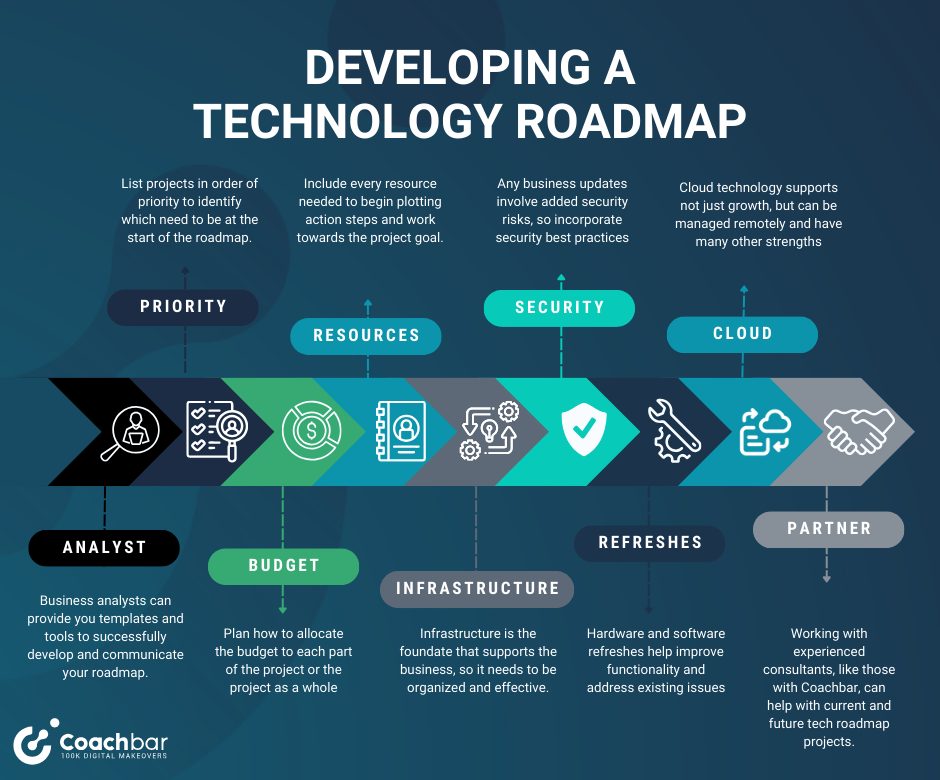Over 90% of businesses have some kind of digital transformation initiative, but only 15% make it a priority. The technology landscape is constantly changing, and it’s the companies that focus on innovation that are leaders in their industries.
This is why a technology roadmap, also sometimes called an IT roadmap, is an essential tool for any business looking to outpace competitors.
With a technology roadmap, your business can map its goals, pivot with the changing landscape, and meet new challenges and opportunities head-on.
If you have yet to create a technology roadmap for your business, this post will provide a comprehensive guide to creating and implementing an effective roadmap of your own.
Table of Contents
ToggleWhat is a Technology Roadmap?
Your technology roadmap is a strategic document that guides your company’s technology strategy. It lays out plans for improving and updating your organization’s technology infrastructure and tech stack based on your overall business goals both now and in the future.
Without a technology roadmap, tracking progress and planning a clear direction for your business is difficult. With this document, you can better understand how technology will support your business and ensure you have the right technology to support growth.
Benefits of Technology Roadmaps
If your company has never had a technology roadmap before, you might be wondering why you would take the time to create one now. Here are some important benefits you’ll get with a well-crafted technology roadmap.
Strategic planning
A roadmap will help align your technology initiatives with your business goals and strategic priorities. This level of strategic planning ensures any technology investments you make are driven by your business needs, not just seasonal trends or short-term goals.
Budget justification
Research from Forrester shows that businesses spend around 72% of IT budgets on existing IT issues and only 28% on innovations and development.
Documenting priorities, timelines, and estimated costs in a roadmap makes securing funding approval from leadership much easier. By having a long-term roadmap showing how new tech investments will ensure business growth, it’s much easier to get buy-in from key stakeholders.
Resource management
Roadmaps provide visibility into future resource requirements to effectively scale staffing levels over time. Without a roadmap, it’s common for businesses to reach bottlenecks once growth outpaces the capacity of current technology systems and staffing levels.
Stakeholder buy-in
Only around 27% of managers believe digitization is a matter of business survival, so it’s important to get all key stakeholders on board and excited about technology changes.
Sharing the roadmap with stakeholders across the organization helps them understand upcoming technology changes and how it will impact their work. This gains support and helps each team member prepare for upcoming changes. Not only does this support training and system acceptance, but it means you’ll get the most out of new technology from the day it’s implemented.
Performance measurement
Comparing actual project progress and outcomes to the roadmap allows your organization to track the overall success and ROI of your technology investments over time. It helps ensure initiatives are delivering intended business value rather than becoming a burden on the company.
Without a roadmap outlining your goals, it’s difficult to measure whether or not you are getting the results you need from new investments, which could be stalling growth.

The 6 Types of Technology Roadmaps
There are six different types of technology roadmaps, which encompass different levels of the software implementation process. From the big-picture strategic roadmap right down to the functional roadmap, you’ll need all six for the best results.
1. Strategic roadmap
The first type is a top-level technology roadmap that takes a high-level, long-term view. Covering three to five years, it shows how technology will support your business strategies and priorities long-term.
Your strategic roadmap is the big-picture view, so it should focus on direction, not tactical details.
2. Tactical roadmap
One level down is the tactical roadmap. This has a shorter, one to two-year view and includes more specific initiatives, timelines, and resource requirements.
This roadmap is a more actionable plan that should include real steps your company can take to work toward your goals.
3. Architecture roadmap
The architecture roadmap supports the tactical roadmap by outlining the hardware, platforms, applications, and infrastructure needed to support your business and long-term goals.
This one should focus purely on technology solutions with both a short and long-term view.
4. Product roadmap
For companies developing technology solutions, the product roadmap outlines the planned features, capabilities, and release schedule for a product portfolio.
5. Project roadmap
Narrower in scope, the project roadmap outlines tasks, dependencies, and timelines for an individual project drawn down from the tactical roadmap.
Having a project roadmap for each project keeps staff members and consultants on track and ensures everyone is working toward a shared goal.
6. Functional roadmap
Each department needs a functional roadmap that details tech initiatives tailored to a specific team’s needs. This is the most detailed of the roadmaps and will differ depending on the department or team (e.g., marketing, sales, support, etc.).
What to Include in a Technology Roadmap
Whether you’re planning on upgrading your software or you simply want a clear direction mapped out for your company, here is everything you need to include in your technology roadmap.
Timeline
Start by thinking about your timeline. Do you want to focus on a one-year, three-year, five-year, or ten-year plan? Having a timeline in place will help you plan achievable goals that fit the given time.
A Current Systems Assessment
You can’t plan improvements without knowing exactly what works and what doesn’t within your current infrastructure. Conduct a full systems review to see where there are bottlenecks, system failures, and room for improvement.
This is also a good time to figure out what already works well so you can build on what’s already successful.
Technology Goals
Your technology roadmap should include both long-term and short-term goals that you want to achieve through the technology implementation.

These goals should focus on current business operations that depend on technology systems, as well as what you’ll need to maintain and improve the systems as your business continues to evolve. Some examples include:
- Boosting efficiency
- Improving security
- Enhancing collaboration tools
- Upgrading hardware and/or software
Priority Projects Linked to Your Business Goals
There will likely be several areas of your current system that could be improved or updated. But start by prioritizing projects that are directly linked to your business goals.
By prioritizing your projects, you’ll see growth that much quicker, which will then give you the time and freedom to revisit non-essential projects.
Budget & Costs
Implementing new software can be a costly process, so it’s important to have a budget planned out alongside the estimated costs of any technology improvements.
With a strict budget in mind, you can focus on finding solutions that align with you’re business’ current financial state rather than ending up in the red investing in software outside of the scope of your finances.
Your budget should also include the costs for software implementation and integration from an expert software consultant. By leveraging the expertise of a software integration partner, businesses see higher ROI and faster time to profitability with new software investments.
Resources Required
What’s needed to reach the goals set out in your technology roadmap? This could be new software, staff training, new staff members, software consultations, etc.
Understanding what resources you need to reach your goals allows you to plan more effectively and prevent delays due to unforeseen challenges.
Success Metrics & Milestones
The milestones you set are key benchmarks achieved in the software implementation process. By tracking success metrics and key milestones, stakeholders can assess and understand the progress toward your company’s long-term goals.
Success metrics are usually tied to specific dates and act as performance checkpoints. When you hit a milestone, take the time to review your progress to make sure you’re still on track, and pivot if you need to.
Getting Started with Your Technology Roadmap
If you’ve never created a technology roadmap before, how do you actually get started? What are the first steps in putting one together? Let’s break it down.
1. Gathering stakeholder input
For any roadmap to be successful, you need key stakeholders onboard. Start by gathering input from different departments to figure out what needs to be included in the roadmap, both long and short-term.
Speak to heads of sales, marketing, customer support, and IT to get vital insights into current processes and what they would like to see improved over the next one to five years.
2. Use Templates for Initial Planning
Luckily, you don’t have to start from scratch with the creation process. There are dozens of IT roadmap templates available for PowerPoint, Excel, Asana, Notion, and any other software you choose.
You can also get help creating the roadmap from professionals. At Coachbar, we have a team of experienced business analysts who will develop your roadmap with you. We’ll take the time to understand your company’s processes and future goals and design a roadmap that helps you reach those goals faster. See an example of a Coachbar Technology Roadmap.
3. Link Your Business Strategy & Objectives
Whether you work with a business analyst, customize a free template, or start the process from scratch, make sure you link your business strategy and objectives. These need to be clear and time-sensitive to get the best results.
4. Set Realistic Project Timelines
We all want results as quickly as possible, but by setting unrealistic deadlines, you’ll put your team under stress and jeopardize the success of your roadmap.
Our business analysts can help you set realistic timelines for any software implementation goals you may have, but you should also include key stakeholders in this part of the process to make sure everyone is on board with the suggested time frames.
Developing Your Technology Roadmap
Once you have the bare bones of your technology roadmap in place, it’s time to develop it into a strategic plan. Here’s how to flesh out your roadmap to turn it into an actionable document.

Find an business analyst to assist you
The sign of a successful technology roadmap is attention to the details. While you can serve as the business analyst and skip having one, you will be slowing your progress due to limits to the time you can commit to finding, interviewing, and documenting the key details of your business.
Business analysts, like those available from Coachbar, can provide you templates and tools to successfully develop and communicate your roadmap. Business analysts that have built technology roadmaps before are particularly valuable since they can guide you through the many complexities and traps involved in moving from idea to fully endorsed and supported IT plan.
Identify Priority Projects
Go through the research you gathered from key stakeholders and create a list of project priorities. You’ll probably notice some trends between departments that show which projects require immediate attention while others could be postponed to a later date.
List your projects in order of priority so you know which ones to add to the start of your roadmap. When it comes to employee efficiency, 74% of businesses surveyed cited communication tools as the driving force, so this could be a good place to start.
Set Project Budgets
Next, it’s time to think about realistic budgets for each project. Some projects may be more far-reaching than others and so will require more investment. If you have a set budget for the entire process, you’ll need to plan how to allocate that budget to the different areas of your roadmap.
Track Resources Needed
What will you need to begin implementing steps to work toward your business goals set out in the roadmap? This could be new software, a software consultant, staff training, new members of staff, etc.
Include every resource you’ll need so you can begin planning action steps to allocate those resources and begin working toward your goals.
Address Infrastructure Upgrades
Most technology roadmaps involve infrastructure upgrades. Your infrastructure is the foundation that supports your business through chaotic growth spurts, so it needs to be organized and effective to help your business scale.
From methods of communication to hiring new staff, think about what your business needs to successfully navigate your new roadmap without hitting roadblocks along the way.
Incorporate Security Best Practices
Any business updates come with added security risks, so now is the time to incorporate new security best practices. This might include staff training, risk assessments, software updates, file back-ups, or updating and securing your Wi-Fi network.
The better prepared you are for system updates, the less likely you are to suffer from a breach or important documentation loss.
Plan Hardware/Software Refreshes
Hardware and software refreshes help improve functionality and address existing issues, such as bugs, crashes, or bottlenecks.
You might decide to stick with your current system and look at upgrades, or you might decide to upgrade to new, more effective software and hardware that can scale with your business.
Consider Cloud Technologies
If you don’t already use cloud technology to back up and secure data, now is a great time to implement this change.
Not only does cloud technology support business growth, it keeps your important documents safe, it can be managed remotely, and it keeps your business up and running in the event of a natural disaster or incident.
Partner with a Software Consultant
Working with an experienced software consultant, like those recommended in the Coachbar directory, can help you with current and future technology roadmap projects. Developing a long-term relationship with one implementation partner that has multi-system expertise allows them to identify key opportunities for your business and save you time and money.
Implementing and Maintaining your Technology Roadmap
Developing a technology roadmap is only the first step of the process; the businesses that stand out from the competition and experience great success are the ones that implement and maintain their roadmaps consistently.
Here are four key steps in implementing a successful technology roadmap for your business:

Revisit & Update Your Roadmap
Plan to revisit your roadmap at least once a quarter, if not more often, to check progress and make sure milestones are being met. Every time you check the roadmap, make updates and tweak any processes that aren’t working as they should.
McKinsey reports that 70% of digital transformations fail due to employee resistance. Without revisiting your roadmap, it will quickly get forgotten about and won’t have the effect you’re looking for.
Measure the ROI of Completed Projects
Whenever a project is completed, review your success metrics and the ROI. Did you hit your goals? If not, what prevented you from hitting those key success metrics?
Measuring the ROI of each project helps you better plan the following phases of your roadmap and gives you the chance to make improvements as you go. Don’t be disheartened if you don’t get the results you were looking for in the beginning, it’s just an opportunity to pivot and improve.
Use Project Management Software
The best way to manage your roadmap and ensure it stays on track is with project management software. This gives you a central hub for tracking progress, keeping team members informed, and making updates as needed.
There are dozens of great project management software options on the market, so research which one works best for your business and goals.
Work with a Software Coach
If all of this sounds like an overwhelming process, a dedicated software consultant can take the stress off of your shoulders.
By hiring a software specialist to help you find and implement the right software for your business goals, you’ll take the guesswork out of your roadmap and ensure your business reaches each milestone.
Create a Successful, Highly Effective Technology Roadmap with Coachbar
No matter what your business goals are, a technology roadmap is essential to help you reach them. By following the steps in this guide, you’ll create an effective, well-researched technology roadmap that can set your business on the path to success.
And if you don’t want to leave this essential document up to chance, we have business analysts here to help you. All you need to do is tell us your business goals and show us a little bit about your current process, and our specialist business analysts will build a successful, highly effective technology roadmap for you.
At Coachbar, we help ensure business choose the best software for their needs.
Let's get started.




